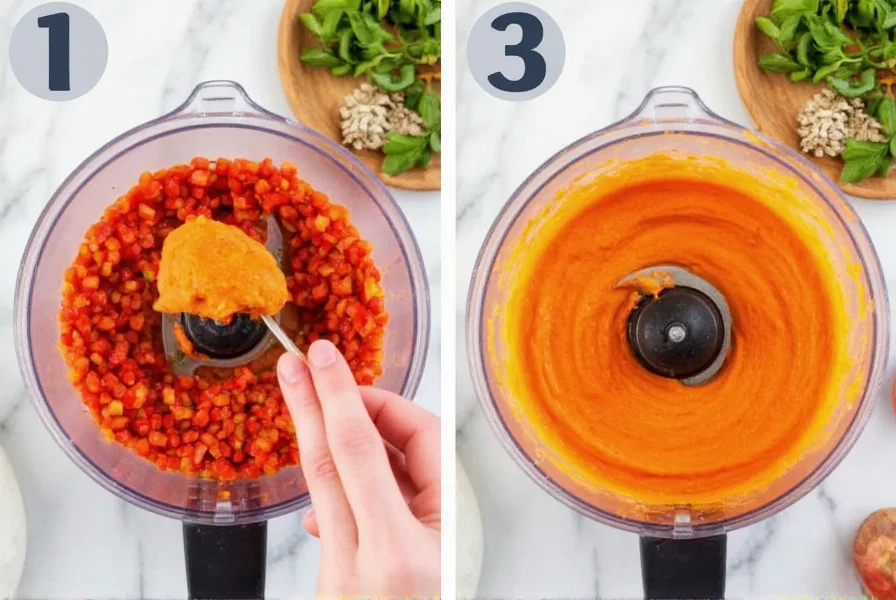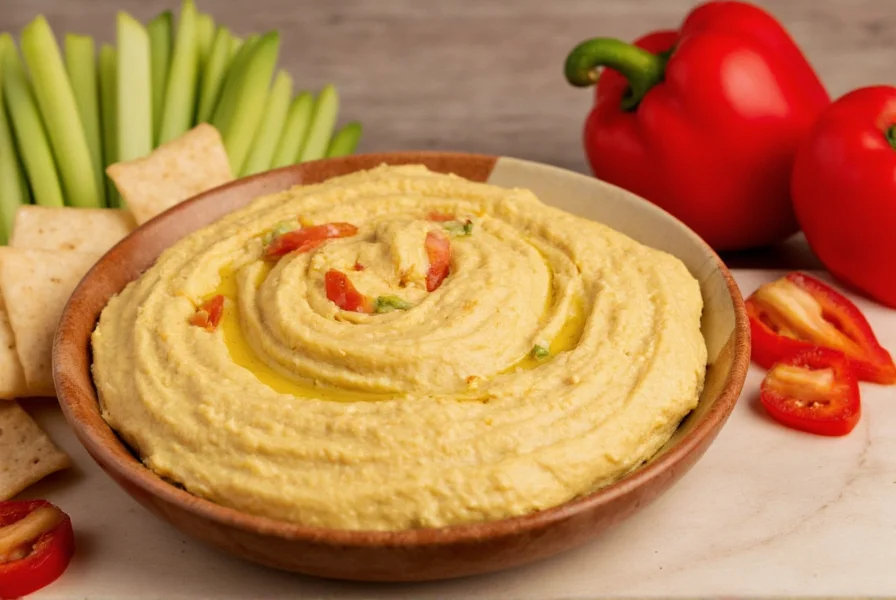The perfect roasted red pepper hummus recipe combines 1 (15-ounce) can chickpeas, 1/2 cup roasted red peppers (drained), 1/4 cup tahini, 2 tablespoons fresh lemon juice, 1 clove garlic, 1/2 teaspoon cumin, 3 tablespoons ice-cold water, and 2 tablespoons extra-virgin olive oil. Blend until ultra-smooth for creamy, restaurant-quality hummus ready in just 15 minutes with simple pantry ingredients.
Roasted red pepper hummus transforms the classic Middle Eastern dip with vibrant color and sweet, smoky flavor. This versatile spread elevates sandwiches, salads, and appetizer platters while delivering plant-based protein and fiber. Unlike store-bought versions loaded with preservatives, homemade red pepper hummus lets you control ingredients and achieve that signature creamy texture impossible to replicate commercially.
What sets this recipe apart is the professional technique of incorporating ice-cold water during blending. This simple step creates an emulsion that results in luxuriously smooth hummus without any graininess. The roasted red peppers add natural sweetness that balances the tangy lemon and earthy cumin, creating a sophisticated flavor profile that appeals to both hummus enthusiasts and newcomers.
Why This Red Pepper Hummus Recipe Works
Most homemade hummus recipes miss three critical elements that separate adequate dips from exceptional ones. First, removing the chickpea skins eliminates fiber that causes graininess. Second, using ice-cold water instead of room temperature liquid creates a stable emulsion. Third, proper seasoning balance ensures no single ingredient dominates. This recipe addresses all three while keeping preparation accessible for home cooks.
Essential Ingredients for Perfect Red Pepper Hummus
The quality of your ingredients directly impacts the final product. Here's what you'll need and why each matters:
| Ingredient | Quantity | Why It Matters |
|---|---|---|
| Canned chickpeas | 1 (15-ounce) can | Convenient and consistently cooked; look for low-sodium varieties |
| Roasted red peppers | 1/2 cup, drained | Provides sweet, smoky flavor; jarred works well for convenience |
| Tahini | 1/4 cup | High-quality sesame paste creates rich base; stir well before using |
| Fresh lemon juice | 2 tablespoons | Bright acidity balances richness; bottled lacks freshness |
| Ice-cold water | 3 tablespoons | Creates smooth emulsion; room temperature water causes graininess |

Equipment Checklist
While you can make hummus with basic tools, these items ensure professional results:
- High-powered food processor or blender (a food processor works better for thicker dips)
- Fine-mesh strainer (for draining chickpeas and optional chickpea skin removal)
- Measuring cups and spoons (precision matters for balanced flavor)
- Rubber spatula (for scraping down sides during blending)
- Airtight container (for proper storage)
Step-by-Step Preparation Guide
Follow these detailed instructions for flawless red pepper hummus every time:
- Prepare chickpeas: Drain and rinse canned chickpeas. For ultra-smooth texture (optional but recommended), gently rub chickpeas between your fingers to remove skins, then drain again.
- Process base ingredients: In food processor, combine chickpeas, tahini, lemon juice, garlic, cumin, and salt. Process 2 minutes until thick paste forms, scraping down sides as needed.
- Incorporate roasted peppers: Add drained roasted red peppers and process 1 minute until fully incorporated.
- Create smooth emulsion: With processor running, slowly add ice-cold water followed by olive oil through feed tube. Continue processing 3-4 minutes until completely smooth and creamy.
- Adjust seasoning: Taste and adjust salt, lemon, or cumin as needed. For thinner consistency, add 1-2 teaspoons additional water and process briefly.
- Chill and serve: Transfer to container, cover surface directly with plastic wrap, and refrigerate at least 1 hour before serving to allow flavors to meld.
Serving Suggestions and Pairings
This vibrant red pepper hummus shines in multiple applications beyond traditional dipping:
- Appetizer platter: Serve with cucumber slices, bell pepper strips, and warm pita bread
- Sandwich spread: Replace mayo in wraps and sandwiches for added flavor and moisture
- Grain bowl base: Create a colorful foundation for quinoa or rice bowls
- Veggie accompaniment: Pair with roasted vegetables like asparagus or zucchini
- Protein topping: Spoon over grilled chicken or fish for Mediterranean flair
Troubleshooting Common Issues
Even simple recipes encounter challenges. Here's how to fix common red pepper hummus problems:
- Grainy texture: Continue processing longer (up to 5 minutes total) and ensure you're using ice-cold water. For stubborn graininess, try passing through a fine-mesh sieve.
- Too thick: Add water 1 teaspoon at a time while processing until desired consistency achieved.
- Too thin: Process longer to thicken emulsion, or add 1-2 tablespoons additional chickpeas.
- Bland flavor: Balance with small increments of salt, lemon juice, or cumin until flavors pop.
- Separation: This indicates improper emulsion. Add 1 teaspoon lemon juice and process again to recombine.
Customization Options
Once you've mastered the basic recipe, experiment with these variations:
- Spicy version: Add 1/4 teaspoon cayenne pepper or 1 teaspoon harissa paste
- Herb-infused: Blend in 2 tablespoons fresh parsley or cilantro
- Smoky depth: Include 1/4 teaspoon smoked paprika
- Extra creamy: Substitute 1 tablespoon of water with plain Greek yogurt
- Oil-free: Omit olive oil and increase water to 5 tablespoons for lower fat version

Storage and Shelf Life
Proper storage maintains both safety and quality of your homemade hummus:
- Refrigerate in airtight container for up to 5 days
- Place plastic wrap directly on hummus surface to prevent oxidation and drying
- Freezing is not recommended as texture changes significantly upon thawing
- Always use clean utensils when serving to prevent contamination
- If water separates on top, simply stir before serving - this is normal
Frequently Asked Questions
Can I make roasted red pepper hummus without tahini?
Yes, you can substitute tahini with 2-3 tablespoons of natural almond or cashew butter for similar creaminess. For nut-free alternatives, increase roasted red peppers to 3/4 cup and add 1 tablespoon of Greek yogurt. The flavor profile will differ slightly but still create a delicious dip.
Why does my red pepper hummus taste bitter?
Bitterness typically comes from either the garlic or the roasted red peppers. Use only 1 small garlic clove and ensure it's fresh (older garlic develops bitter compounds). If using jarred roasted peppers, rinse them thoroughly to remove any brine that might contain bitter preservatives. Adding an extra 1/2 teaspoon of lemon juice usually counteracts bitterness.
How can I make red pepper hummus smoother without a high-powered blender?
For ultra-smooth texture with basic equipment, remove chickpea skins by rubbing them between your fingers after draining. Process ingredients in stages: first blend chickpeas with tahini and lemon until smooth, then add remaining ingredients. Most importantly, process for at least 4 minutes total, stopping to scrape down sides frequently. The extended processing time breaks down fibers for creamier results.
What's the best way to roast red peppers for homemade hummus?
For optimal flavor, roast peppers directly over gas flame or under broiler until blackened on all sides. Place in covered bowl for 10 minutes to steam, then peel skin and remove seeds. This method creates deeper smoky notes than jarred peppers. One large roasted pepper yields approximately 1/3 cup chopped, perfect for this recipe's 1/2 cup requirement.
Is red pepper hummus healthier than regular hummus?
Red pepper hummus offers similar nutritional benefits to traditional hummus with added vitamin C and antioxidants from the peppers. Both versions provide plant-based protein and fiber. The roasted peppers contribute minimal additional calories while enhancing the nutrient profile. The healthiest version uses minimal added oil and relies on the natural creaminess from properly processed chickpeas.











 浙公网安备
33010002000092号
浙公网安备
33010002000092号 浙B2-20120091-4
浙B2-20120091-4